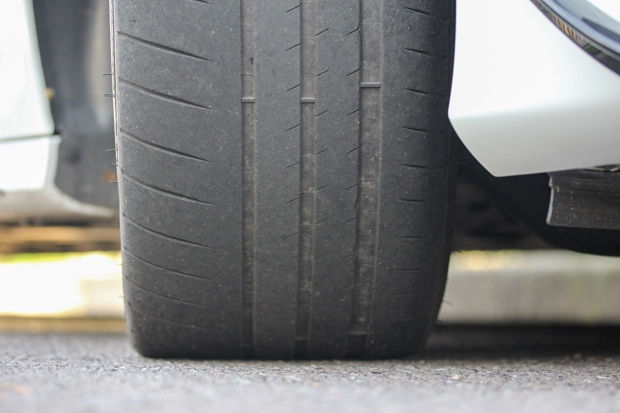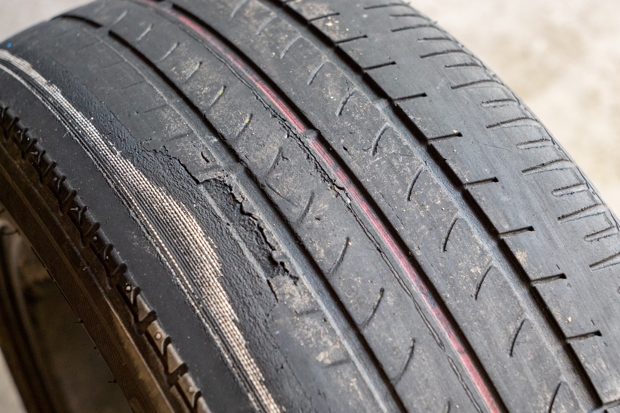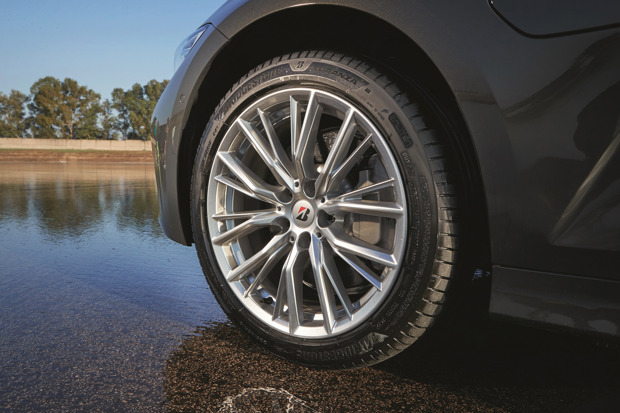What makes your tyres illegal?
Driving on illegal tyres isn’t just unsafe, it could land you with a £2500 fine and three penalty points per tyre. Here's what can make your tyres illegal.

- How to check if your tyres are illegal
- How tyres wear over time
- How to best maintain your tyres
They’re the only part of your car that touches the road, yet for many drivers, tyres remain an afterthought. With millions on the road and hundreds to choose from, finding the right one - and knowing when to replace it - is what really matters.
So here, with expert help from Bridgestone, we explain why tyre performance evolves over time, how to stay safe in changing conditions and most crucially what makes a tyre illegal.
Tyre safety facts
- In 2023, 190 people were killed or seriously injured in accidents involving defective tyres
- Over 6 million tyres in the UK are found with illegal tread depth every year
- More than 2 million MoT failures occur every year because of tyre defects
- £1 billion in fuel is wasted annually due to underinflated tyres
(source Tyresafe 2025)
What makes a tyre illegal in the UK?
So how do you know if your tyres are illegal? This checklist, and advice from Bridgestone North Region Technical Manager Peter Moulding, will help you make sure you stay on the right side of the law.
Tread depth below 1.6mm
The legal minimum tread depth is 1.6mm across the central three-quarters of the tyre, around the entire circumference. Anything below this is illegal.
Cuts and bulges
The ply cords form the strength of the tyre carcass, allowing the tyre to be pressurised without ballooning and bursting. Therefore any damage to these cords can result in a dangerous situation as broken/damaged cords produce a weakness within the tyre - which can be seen as a bulge.
Such weaknesses will be most likely to fail when the tyre is under the most amount of stress (for instance when at speed on a motorway) which is also the time you need to depend on your tyres most. This is why any damage to a tyre which reaches the ply cords, or any break in the ply cords makes the tyre illegal.
Similarly if any cut exposes the steel reinforcing belts, this lets moisture into the tyre, allowing corrosion and weakness in the tyre, which is why any cuts to belts makes a tyre illegal.
It is important to note that the reasons for these laws are for safety to all road users, so please do not ignore damage which makes a tyre illegal, you may not get caught by the police, but you will be putting yourself and other road users in danger.
Overly worn shoulders or uneven wear
This could suggest suspension or alignment issues. And if any part of the tyre falls below the legal tread limit, it’s illegal.
"Many drivers only look at the centre of the tyre, but wear on the inner or outer shoulders can still make it illegal. Regularly checking your tread – and rotating your tyres – can keep you safe and legal," suggests Moulding.
A simple way to check? Use a 20p coin. Insert it into the main groove. If the outer rim is visible, your tread is likely close to or below the legal limit. Alternatively you can buy a tyre tread depth gauge - a digital one will set you back about £5.

How tyres wear over time
No matter whether your tyres are premium, mid-range, or budget, their performance doesn’t vanish overnight but fades gradually.
As tread wears, the precisely engineered grooves and patterns that evacuate water and provide grip diminish. That means reduced handling and an increased risk of aquaplaning in the wet.
For most everyday drivers, it’s water clearance that matters most. The tread grooves that disperse water become shallower over time and on wet roads at speed - especially on motorways - this can lead to aquaplaning, where the tyre loses contact with the road altogether.
Independent tests show a sharp increase in braking distance once tread depth falls below 3mm, which is why that’s the generally recommended point to consider a replacement.
While tyre manufacturers engineer tyres to perform safely even down to the legal minimum 1.6mm, there is a note of caution. "That last millimetre is where performance can start to drop off fast," says Moulding.

Tyre care - the basics that make a big difference
Good tyre care goes beyond choosing the right product. Regular checks help you stay safe and extend tyre life.
Here are the key things to regularly check
Tyre pressures
You should check tour tyre pressures every two weeks. Under-inflated or over-inflated tyres impact handling, fuel economy and wear. You can get digital home tyre inflators for less than £20.
Tread depth
Use the 20p test or better still, spend a few quid on a tread depth gauge and make sure to measure the central three-quarters of the tyre. We'd always suggest replacing before you reach the legal limit.
Visual checks
Look for cracks, bulges, cuts or uneven wear. These may seem minor and it's easy to ignore, but damaged tyres are most likely to fail when their at their most stressed, so at higher speeds or in corners.
"What really matters is staying one step ahead of wear and weather," says Moulding.
What are the different types of tyres?
When choosing your tyres, the best advice is to go for the right tyre based on your driving needs, climate, and performance expectations.
Summer Tyres
Designed for speed, agility and performance, summer tyres offer superior grip, handling and braking in warm, dry and wet conditions. Shallower tread patterns are designed to maximise contact with the road for improved precision and cornering.
Winter Tyres
Winter tyres stay soft and grippy in cold conditions. They are essential for icy or snowy roads. However, they wear faster and perform poorly in warm weather, so should always be swapped out in spring.
All Season Tyres
A versatile option for moderate climates, all-season tyres balance performance across dry, wet and light snow conditions. They are not as specialised as summer or winter tyres, but ideal for drivers wanting year-round convenience.
